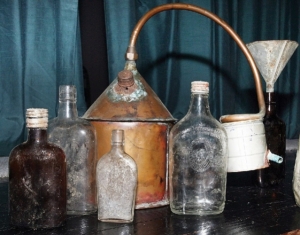Moonshine exhibit planned at Wayne County Museum
By Catharin Shepard
Published in News on August 27, 2009 1:46 PM

News-Argus/MITCH LOEBER
This 1970s moonshine still is one of several on display at the museum's upcoming exhibit "Inns, Taverns and Moonshine Madness." The museum is also seeking other moonshine paraphernalia to display. The exhibit will also feature firsthand accounts from moonshiners.
Whether you call it mountain dew, pop-skull, forty-rod or just plain old white lightning, moonshine and the people who made it are an indelible part of North Carolina's history, and now the Wayne County Museum is setting up a few (empty) stills of its own.
The liquid lightning that gave birth to NASCAR racing is the focus of "Inns, Taverns and Moonshine Madness," a brand-new exhibit set to open Sept. 15 at the museum on William Street.
Moonshiners operated in the United States as early as the Colonial period, but it was in the 1920s and 1930s, the years of Prohibition and immediately thereafter, that the untaxed and illegal liquor production distilled into the much-storied era known today.
North Carolina was heralded as the first state in the Union to outlaw liquor traffic by popular vote, said Chris Lawson, assistant manager at the Wayne County Museum, and from eastern swamps to the mountains in the west, moonshiners started setting up production.
"North Carolina has a lot of history dealing with moonshine. That's how NASCAR started," Lawson said.
The moonshiners had to transport their bottled goods to sell them and started modifying their vehicles to be able to outrun police who were on the lookout for bootleggers.
One legendary North Carolina moonshiner, Junior Johnson, went on to have a famously successful career as a race car driver in the early days of NASCAR. The museum will even have a jar of Johnson's own new, legally produced moonshine on display, Lawson said, along with moonshine jelly, several authentic stills and a variety of jars, flasks and bottles used to hold liquor.
Many of the items are on loan from the Tobacco Farm Life Museum in Kenly, and organizers are also seeking to borrow moonshine paraphernalia from locals to put on display this fall.
The exhibit will also feature guest speakers George Robert Powell Sr., author of "Moonshine, Fast Cars and Revenuers: Moments From My Life in Law Enforcement," and Frank Stephenson, son of a sheriff who often took the teenage Stephenson on patrol while hunting moonshiners. Powell will be at the museum Oct. 2 at 7 p.m. to give a presentation and sign copies of his book, and Stephenson will speak at a date to be announced.
The museum will have large displays of tales from moonshiners and the law enforcement officers who chased after them, and the television in the main room will play a video about the history of moonshine.
Besides the moonshine exhibits, the museum will have information and displays on inns and taverns, an important part of the early economic and geographic development of Colonial North Carolina. Known as "ordinaries," the establishments were known not only for offering alcohol but also for providing food and lodging to travelers in the 1800s, Lawson said.
The museum also will in December premiere a special exhibit marking the 150th anniversary of the Goldsboro Rifles, the local militia unit that volunteered for service in the Confederate Army during the Civil War and saw action in some of the war's greatest battles, including Antietam, Fredericksburg and The Wildernesss.
The current train exhibit will close today to allow staff and volunteers to switch out the exhibits.
The "Inns, Taverns and Moonshine Madness" exhibit will run until the end of the year.
The museum is open Tuesday through Friday from 11 a.m. to 4 p.m. and Saturday from noon to 4 p.m., but will be closed on Labor Day.
For more information about the Wayne County Museum or any of its exhibits, visit http://www.wayne countyhistoricalnc.org.
